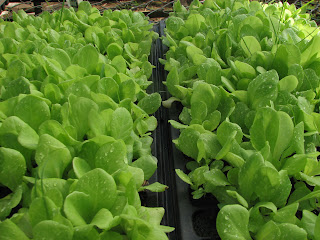¨Farms produce more than just food. They also produce a kind of landscape and a kind of community." - Michael Pollen

Below is a mandala garden created by students at EARTH. The concept of the Mandala is that it can provide a family with a balanced diet, a financial income, and renew local natural resources.
It is designed in 8 rings with the first center ring functioning as the watering sources and habitat for small animals such as rabbits, chickens and ducks. Outside the center ring, a balanced diet of veges, fruits, legumes and medicinal and edible herbs grow in the following 3 rings. Continuing outward, the next three rings provide the family with a surplus of food that can be sold locally for financial income or produce to barter. The outer eighth ring functions as a protection ring – such as an animal barrier and/or a windbreak.

The garden is laid out in a pattern which enables the whole garden to be watered from one central point, allows access to all parts of the garden while maximizing growing space, is aesthetically pleasing, and, by facing the entrance to the East, optimizes subtle energy flows. Plantings are planned to allow light & air to reach all plants, & to take advantage of nature's methods of 'pest' control,e.g. scattering plants of similar species, attracting & providing habitat for natural predators, & companion planting.

Planting by the moon is an idea as old as agriculture, based both in folklore and superstition, but there are scientific ideas to back it up The Earth is in a large gravitational field, influenced by both the sun and moon. The tides are highest at the time of the new and the full moon, when sun and moon are lined up with earth.
Just as the moon pulls the tides in the oceans, it also pulls upon the subtle bodies of water, causing moisture to rise in the earth, which encourages growth. The highest amount of moisture is in the soil at this time, and tests have proven that seeds will absorb the most water at the time of the full moon.
-Source: www.gardeningbythemoon.com/phases.html

Young lettuce leaves we transplanted in the Mandala garden.

Transplanting cilantro and setting up a shade cover to protect the new plants from getting burned.

I spent one morning in another garden with three students double-digging this plot to prepare for new transplants. Double-digging is a method of soil preparation that loosens the soil to a depth of 60 cm. The result is a bed raised above the original ground level. It allows more efficient root growth and nutrient absorption, making strong healthy crops. Water retention is also improved and microbial activity is stimulated by the availability of water and air.
Weeding in preparation for rainy season

With the rainy season on its way, cluttered leaves and weeds around the pineapple plants had to be cleared so the water can reach their roots. In the dry season, the leaves help to keep in as much moisture as possible.

It takes an organically grown pineapple one full year in to grow in the tropics.

Inside the greenhouse, a student did an experiment to see which medium of added nutrients made the lettuce grow the fastest and strongest. In the farthest bed, she added calcium into the soil with no compost. In the next bed, she added ready compost made of pig manure and other organic material. In the third bed, she mixed in EM (Effective Microorganisms). The final and closest bed, teaming with rich worm castings, was harvest first and had the healthiest leaves.
Vermiculture

Vermicompost is one of the best organic fertilizers. Worms feed on decomposing food scraps, other organic matter and animal manure and produce a more broken down form of nutrients in their manure, called castings. Workers on the organic farm at EARTH (picture below) directly feed their red California worms fresh pig manure. I learned that plants receive nutrients from the worm castings more directly if the worms ate manure from single stomached animals like pigs instead of ruminant animals like cows.

In soil, castings hold water and release nutrients in a form well-suited to plants. Castings are a concentrated fertilizer that is most efficiently used as a portion of a planting mix, but still won’t “burn”plants if applied more heavily. Also, castings contain plant growth hormones that provide an energy “kick”to plants.
To get the castings out without removing the worms, the area must be deprived of water and food (manure, food scraps)so that the worms move over in search of the next moist and nutrient rich area.
Vermicompost is a low-tech solution to organic solid waste disposal.
Managing compost heaps

This is a 8-week cycle compost system. Every week, the piles are moved to the next area and in the process turned and mixed. The decomposing material needs to be aerated so that it doesn't reach an extremely high temperature that will kill beneficial bacterias and nutrients. 120 F degrees is a good max temp. This system is more practical if enough space is available to have many piles; however any heap of compost can be managed in a small space by turning a pile in place.

Rice bags are filled with ready compost that is taken out to the gardens.
-------------
“Effective Microorganisms,” or “EM” for short:

This is an incredible substance in the garden that functions as plant nutrition, pest control agent, soil builder, and all-around ecosystem enhancer.
EM A (active EM) is an inoculate of microorganisms cultured using compost, sugar, and a bit of the local soil. By mixing different beneficial microorganism, they form a balance to fight against pathogens. Microbes are a crucial part of every ecosystem.
Ingredients: EM 1= 5%; Molasses=5%; Water= 90%
It ferments for 8 days and has a life span of 1 month.

Compost teas have often been confused with EM-1. Compost tea is a liquid extract made from aerobically bubbling air through compost in order to grow aerobic microbes. The tea's quality is directly related to the quality of the compost and has a very short shelf life. The aerobic microbes require air to stay alive. Once the air is gone, they start to die off. Compost tea quality varies from batch to batch as the microbial populations vary with each new batch.
Source: www.emamerica.com/compost-teas-with-effective-microorganisms

EM-5 is natural insect repellent. Ingredients: EM-1 = 10%, Molasses = 10%, Vinegar = 10%, Alcohol =10%, Water = 60%; garlic and chile can also be added. It ferments for 1 month and has a life span of 6 months.
At EARTH's organic farm, Ricardo and I diluted EM-5 concentrate in water and sprayed the water buffalo to repel some nasty bugs that bore into their skin, lay eggs and hatch worms. The following day, Ricardo had to inject a chemical into their blood stream as well to kill any existing eggs and worms. EM-5 is only a repellent.


Ricardo spends a couple hours each day with this water buffalo training it to follow the lead of a rope. This is a very long, tedious process especially because this particular buffalo is already 3 years old and pretty set in his ways. He strongly resists the tug of the rope around his head and neck, not yet ready to give in. However, Ricardo is practicing an old method that is alternative to the quick, more brutal method that trains the buffalo by pain and fear.


Permaculture advocates care of all living things in a way that harmonizes with the patterns and cycles of nature. By taking the time and care with this animal, Ricardo was promoting that principle.

After this semester, growing food the organic way and designing my life around the Permaculture principles is the most obvious path to take. Permaculture is not so much about this thing or that thing, but how those things relate. It is about relationships. There is no across the board solution for any problem. Its based on experience and tradition, but there is also the element of rechecking and re-observing. It is about seeing what works and doesn't work then adapting to that knowledge.

Permaculture is the most comprehensive and wholistic design approach being taught on the planet. It holds a reverent appreciation for nature, and strives to empower people to connect to the ecosystem in which they live, understanding that we are necessary and active members in that community of people, plants, animals, fungi, water, and air.

CARE FOR THE EARTH:
Protect and create wildlife niche and habitat
Increase biodiversity
Protect watersheds
CARE FOR PEOPLE:
Teach and use sustainable design
Increase agrobiodiversity
Strengthen and enliven local culture
Create thriving local economies
Value indigenous knowledge
DISTRIBUTE THE SURPLUS:
Share seeds and plants
Share harvest
Share knowledge and skills
"What permaculturists are doing is the most important activity that any group is doing on the planet. We don't know what details of a truly sustainable future are going to be like, but we need options, we need people experimenting in all kinds of ways and permaculturists are one of the critical groups that are doing that."
-- Dr. David Suzuki
biologist, geneticist, broadcaster & international environmental advocate

